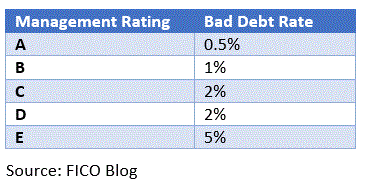How to Rate Trade Credit Risk – Without Much Data
Blog: Enterprise Decision Management Blog

Allowing people or businesses to pay for things on credit is an ancient practice, and just as ancient is the dilemma: How can you tell if they will pay you back? We know how this works when lending to individuals, but sometimes granting trade credit is trickier.
I recently went to visit a new FICO client who are involved in the bunkering industry. Bunkering is the business of providing fuel to shipping, and our client offers credit lines to cruise lines, oil firms and any company that needs to fill up its large vessels with black gold and all its refined derivatives.
Like any other institution that offers trade credit (typical firms will pay a bunkering firm within 30 days for the fuel it has purchased), they have a bad debt problem, which is particularly important in an industry with small margins. Although some bunkering firms have turnovers well into the billions of dollars, they tend to make a profit of around 1-2% on each transaction, so a few clients who don’t pay up can make a serious dent in the financials.
The company were asking me to advise them on the production of a ratings model, to help them rank their customers, old and new, for risk. Part of the problem in their industry is the lack of information – whilst we’re used to some of the leading banks that FICO works with having enormous Big Data lakes, predictive data is hard to come by in the bunkering industry.
The answer of course is to make use of subjective data, and this is quite common in Ratings Models across several industry sectors. For example, a firm might assess certain qualitative aspects of their clients, say “management capability”, and assign them a grade based on that. We can then see whether there is any link between these subjective opinions and actual outcomes.

We then use this kind of information in the development of a scorecard, together with financial information on clients, internal behavioral data and external data. Sometimes it just takes a little bit of imagination and experience to use this data creatively and in a powerful way.
For example, many industry sectors have bespoke credit reference agencies (such as Dynamar) that offer risk grades and recommended credit limits. Rather than use the recommended credit limits as suggested, simply matching an external risk grade to performance data including bad debt outcomes and previously offered limits will, with a little bit of clever hard sums, help create bespoke credit offers that can give you the commercial edge.
All of these data items can be combined to provide input into a statistically robust ratings model that can transform your credit assessments and lending practices. Don’t have any historic data to build a scorecard on? Analytically driven random sampling of your portfolio (to make sure you get a proper representation of your client base) and then “back-filling” key data items can help produce a modelling dataset for a Ratings Model that will still give you a competitive advantage and can be used whilst you build up a more robust analytics data set.
As a B2B enterprise offering credit to a specialised market, there are quick and cost-effective ways to bring the power of analytics to play in your credit decisioning. Hard sums and data isn’t just for the banking bunker – it has power to transform any business that needs to minimize bad debts and make the right kind of credit decisions.
The post How to Rate Trade Credit Risk – Without Much Data appeared first on FICO.
Leave a Comment
You must be logged in to post a comment.







